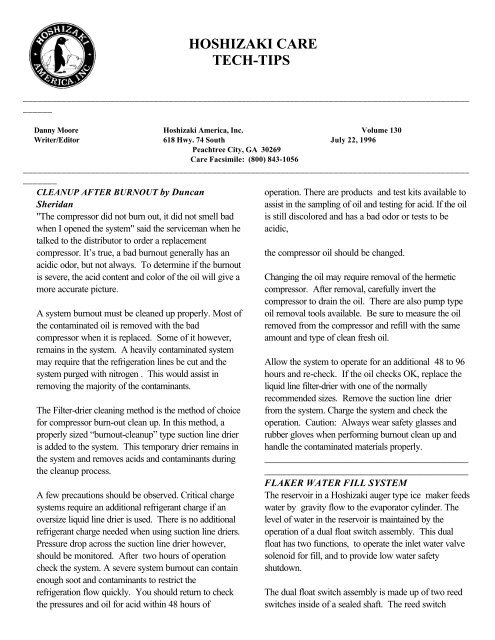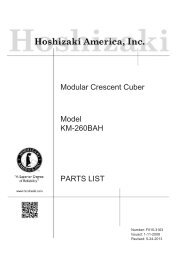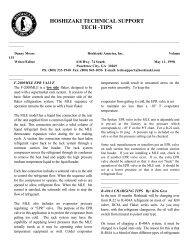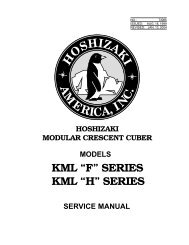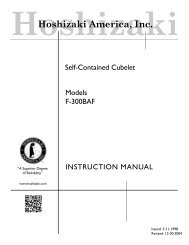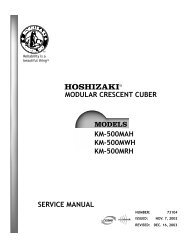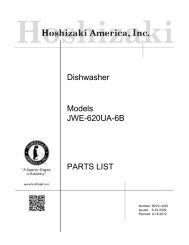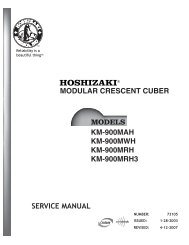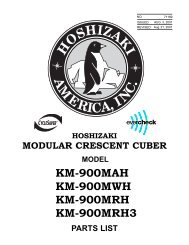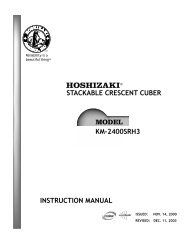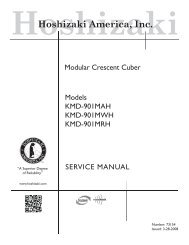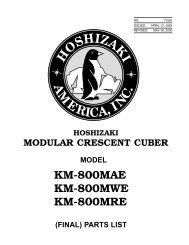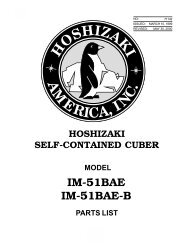HOSHIZAKI CARE TECH-TIPS - Hoshizaki America, Inc.
HOSHIZAKI CARE TECH-TIPS - Hoshizaki America, Inc.
HOSHIZAKI CARE TECH-TIPS - Hoshizaki America, Inc.
Create successful ePaper yourself
Turn your PDF publications into a flip-book with our unique Google optimized e-Paper software.
<strong>HOSHIZAKI</strong> <strong>CARE</strong><strong>TECH</strong>-<strong>TIPS</strong>__________________________________________________________________________________________________Danny Moore <strong>Hoshizaki</strong> <strong>America</strong>, <strong>Inc</strong>. Volume 130Writer/Editor 618 Hwy. 74 South July 22, 1996Peachtree City, GA 30269Care Facsimile: (800) 843-1056___________________________________________________________________________________________________CLEANUP AFTER BURNOUT by DuncanSheridan"The compressor did not burn out, it did not smell badwhen I opened the system" said the serviceman when hetalked to the distributor to order a replacementcompressor. It’s true, a bad burnout generally has anacidic odor, but not always. To determine if the burnoutis severe, the acid content and color of the oil will give amore accurate picture.A system burnout must be cleaned up properly. Most ofthe contaminated oil is removed with the badcompressor when it is replaced. Some of it however,remains in the system. A heavily contaminated systemmay require that the refrigeration lines be cut and thesystem purged with nitrogen . This would assist inremoving the majority of the contaminants.The Filter-drier cleaning method is the method of choicefor compressor burn-out clean up. In this method, aproperly sized “burnout-cleanup” type suction line drieris added to the system. This temporary drier remains inthe system and removes acids and contaminants duringthe cleanup process.A few precautions should be observed. Critical chargesystems require an additional refrigerant charge if anoversize liquid line drier is used. There is no additionalrefrigerant charge needed when using suction line driers.Pressure drop across the suction line drier however,should be monitored. After two hours of operationcheck the system. A severe system burnout can containenough soot and contaminants to restrict therefrigeration flow quickly. You should return to checkthe pressures and oil for acid within 48 hours ofoperation. There are products and test kits available toassist in the sampling of oil and testing for acid. If the oilis still discolored and has a bad odor or tests to beacidic,the compressor oil should be changed.Changing the oil may require removal of the hermeticcompressor. After removal, carefully invert thecompressor to drain the oil. There are also pump typeoil removal tools available. Be sure to measure the oilremoved from the compressor and refill with the sameamount and type of clean fresh oil.Allow the system to operate for an additional 48 to 96hours and re-check. If the oil checks OK, replace theliquid line filter-drier with one of the normallyrecommended sizes. Remove the suction line drierfrom the system. Charge the system and check theoperation. Caution: Always wear safety glasses andrubber gloves when performing burnout clean up andhandle the contaminated materials properly.____________________________________________________________________________________FLAKER WATER FILL SYSTEMThe reservoir in a <strong>Hoshizaki</strong> auger type ice maker feedswater by gravity flow to the evaporator cylinder. Thelevel of water in the reservoir is maintained by theoperation of a dual float switch assembly. This dualfloat has two functions, to operate the inlet water valvesolenoid for fill, and to provide low water safetyshutdown.The dual float switch assembly is made up of two reedswitches inside of a sealed shaft. The reed switch
contacts are operated by individual magnets attachedinside of the two separate floats.As ice is made and extruded from the evaporatorcylinder, the water level in the reservoir drops. Whenthe level drops, the top float opens the top switchcontacts (considered a latching circuit). Opening thesecontacts allows the bottom float switch controlof the water control relay in the control circuit. As thewater level continues to drop, the bottom float contactsopen to de-energize the water control relay.De-energizing the water control relay closes a circuit tosupply 24 volts to the inlet water valve solenoid. Thisallows water to fill the reservoir. It also opens a circuitto the timer board which starts a 90 second low watersafety shutdown timer.When the water supply is available, the reservoir refills.As the reservoir level rises, these two switches swapjobs. The bottom float is now the latching circuit andthe top float re-energizes the water control relay. Thiswill stop the safety timer and shut off the water flow.If no water is available, i.e. the filter is stopped up orthe water supply is turned off, the unit cycles down andthe water valve remains energized. When the watersupply is restored, the reservoir fills and the top floatswitch re-energizes the water control relay toautomatically restart the unit. This system provides aconsistent water level in the reservoir and an automaticreset low water safety protection.The dual float switch has three wires. The black wire iscommon, the red is for the top switch and the blue is forthe bottom. Check the top switch by ohming out theblack and red wires. When the top float is up thisswitch should be closed. Check the bottom switch byohming out the black and blue wires. Raise the bottomfloat and the contacts should close. If either switch fails,the assembly should be replaced.Since the float switch is mounted into the waterreservoir, it is susceptible to scale build-up. Theamount of scale build-up will depend on the local waterquality. Scale on the switch shaft can cause the floatsto stick. This will effect the unit operation. In this case,the float switch should be cleaned and checked.The float switch is held in place on the top cover by atwist lock bracket. To remove it, twist the switch flangeand lift. Soak the switch assembly in ice machinecleaner. While it is not necessary to do so, someservicers remove the floats from the shaft duringcleaning. If you remove them, note that the blue float ison top. Also it is important to clearly mark the top ofthe floats so that they can be replaced correctly. Themagnet is always on the top of the float. Installing thefloats upside down will effect the timing of the floatswitch operation. Once clean, rinse and wipe thecleaner off and check the switch with a good qualityohm meter.See Service Bulletin number SB96-0003 for a detaileddrawing of the dual float switch assembly.____________________________________________________________________________________KM BIN CONTROL EXTENSIONEffective on models produced in June 1996, A newstainless steel bin control extension bracket has beenadded as a standard accessory for all KM / S models.The extension bracket is designed to be used with non-<strong>Hoshizaki</strong> bin applications, on all KM-2000 & 2400’sand whenever units are stacked. Using the bracketextension lowers the bin control bulbs and shifts the bulblocation so that proper operation of the bin control canoccur.Two problems have been solved by adding thisextension. 1. On non-<strong>Hoshizaki</strong> bins, there may not bea baffle to direct the ice pyramid towards the bin controlbulbs. Adding the extension redirects the ice pyramidimproving bulb contact.2. When units are stacked, the standard bracket maynot allow enough space between the ice pyramid andthe bottom of the lower unit for the ice drop weight oftwo units to flow into the bin. This drop weight couldequal either 62 lbs. or up to 92 lbs. depending on themodels and application.


